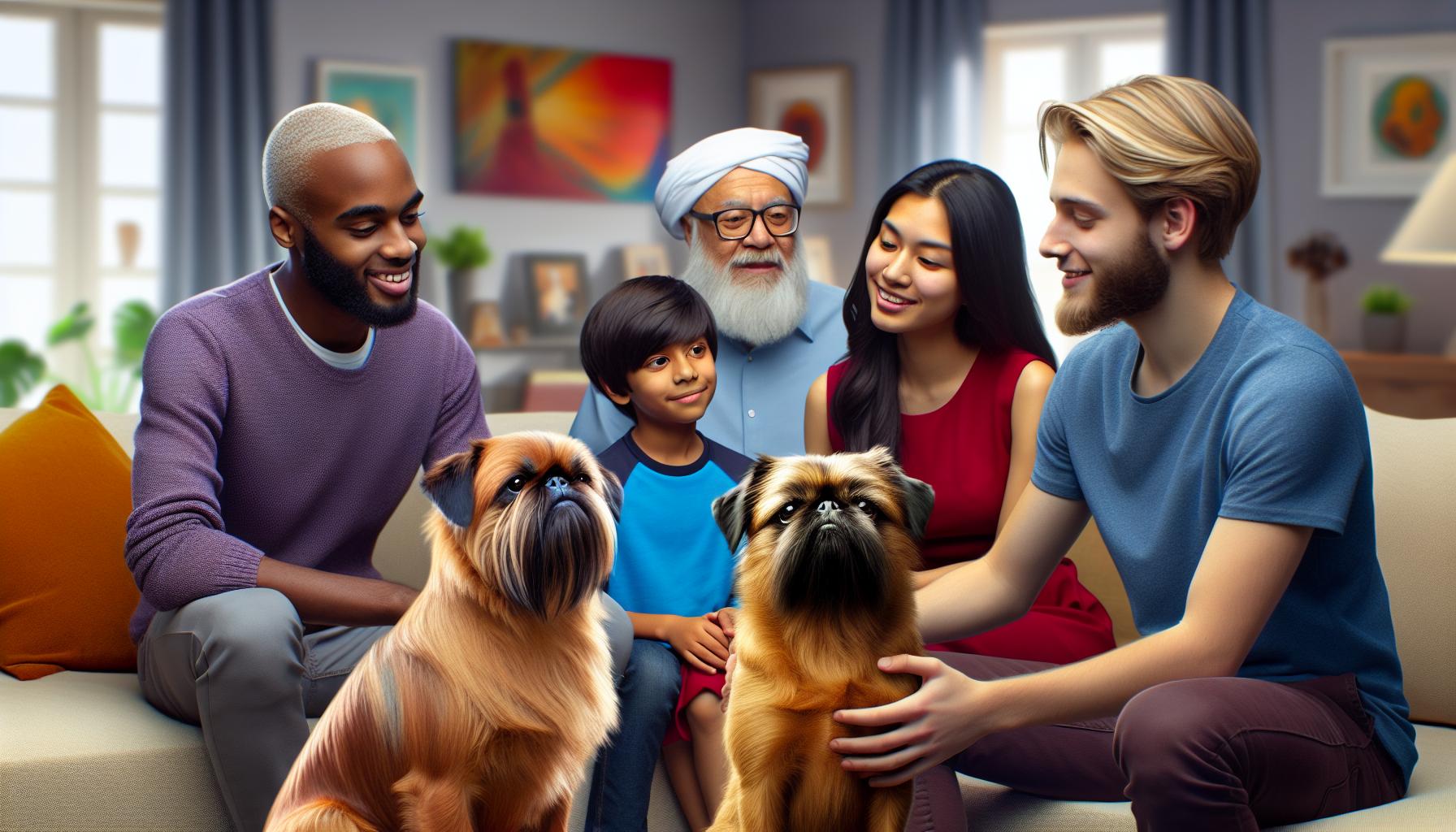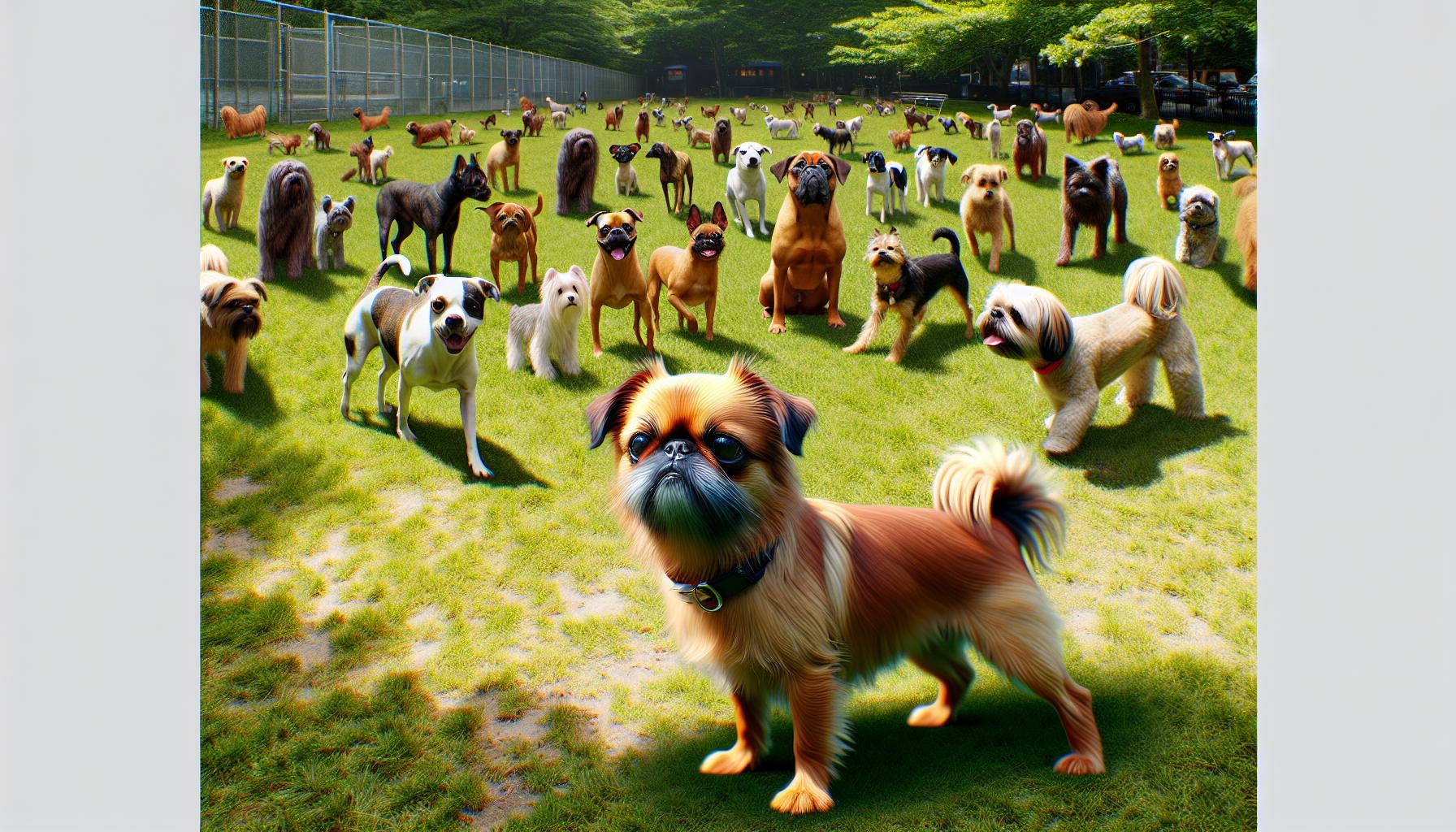If you’ve ever met a Brussels Griffon, you know they’re not just any dog. With their distinctive bearded look and big, soulful eyes, they’re like little, furry people with a zest for life that’s contagious. But it’s not just their appearance that makes them stand out; it’s their vibrant social life.
These pint-sized pups are the life of the party, forming deep bonds with their human families and showing a keen interest in making friends, both canine and human. They’re not just pets; they’re members of the family with a social calendar that could rival yours. Let’s dive into the bustling social world of Brussels Griffons and discover what makes their social life so special.
Origins of Brussels Griffons
Delving into the past, you’ll find the Brussels Griffon originates from Belgium, with roots deeply entrenched in the city of Brussels. This breed, often synonymous with its sprightly nature and almost human-like expressions, has a history that might surprise you. Initially bred from the Affenpinscher and the Belgian street dog – a mix designed for the task of keeping rat populations at bay in stables – the Brussels Griffon quickly transcended its humble beginnings.
By the late 19th century, these charming dogs caught the eye of the Belgian nobility. Their unique appearance, coupled with their spirited disposition, made them highly sought after by nobles and royalty alike. It wasn’t long before the Brussels Griffon became a symbol of status and sophistication in European high society.
The breed’s popularity saw a significant upturn internationally when Queen Marie Henriette, a renowned dog enthusiast, took a particular liking to the Griffon. Her passion for the breed led to its widespread recognition and admiration across Europe. During this period, the breed was refined and the distinct characteristics we love today – the pouty face, the intelligent eyes, and the steadfast loyalty – were meticulously developed.
The journey of the Brussels Griffon from the streets of Brussels to the laps of royalty is a testament to their undeniable charm and companionship. Today, these dogs are beloved members of families far and wide, known for their considerable social prowess and ability to form deep emotional bonds with humans.
As you continue to explore the social nuances of the Brussels Griffon, it becomes evident that their history plays a pivotal role in shaping their vibrant social interactions and deep-seated need for companionship.
Distinctive Physical Characteristics

As you delve deeper into the world of Brussels Griffons, you’ll quickly notice their distinctive physical characteristics that set them apart from other breeds. These small yet sturdy dogs boast a charismatic personality that is often reflected in their unique appearance. Key features include a human-like expressive face, highlighted by large, dark eyes that draw you into a gaze full of depth and emotion. It’s hard not to be charmed by their look, which combines both eagerness and a pout that seems to reflect a perpetual state of thoughtful contemplation.
Their faces are framed by a fringed beard and mustache, a hallmark of the breed, adding to that almost wise, distinguished look they carry. What’s truly fascinating about Brussels Griffons is their coat, which can vary greatly, coming in rough or smooth varieties. The rough-coated Griffons showcase a wiry texture that demands regular grooming to maintain its distinctive appearance. On the other hand, smooth-coated ones present a sleek look with minimal grooming needs, yet both types share the same lovable essence.
Size-wise, they are quite compact, making them perfect companions for city dwelling or living in smaller spaces. Here’s a quick glance at their typical size:
| Feature | Measurement |
|---|---|
| Height | 7-10 inches |
| Weight | 6-12 pounds |
Their small stature, however, doesn’t dampen their spirited personality. Brussels Griffons possess a robustness and vitality that belie their petite frame.
Within the realm of these characteristics, it becomes evident why Brussels Griffons form such deep bonds with their human counterparts. The combination of their expressive eyes, distinctive facial features, and size creates the perfect companion whose physical attributes are only matched by their rich social behaviors and deep emotional connections with humans. Their ability to communicate without words, using just a look or a tilt of the head, enriches the lives of those who choose to make these remarkable dogs part of their family.
Social Bonding with Human Families

Brussels Griffons are known for their affectionate nature and their uncanny ability to form deep connections with their human families. From the moment you bring a Griffon into your home, you’ll notice their eagerness to become an integral part of the family dynamic. They thrive on constant interaction and can often be found following their human companions from room to room, never wanting to miss a moment of the action.
Despite their small stature, Brussels Griffons have big personalities. They are adept at using their expressive faces to communicate their needs and feelings, often in surprisingly human-like ways. Whether it’s a tilt of the head to show curiosity or a paw gently placed on your lap to seek attention, they have their unique ways of engaging with you. This level of communication fosters a strong bond between you and your Griffon, making them more than just pets—they become cherished members of the family.
Griffons are also known for their sensitivity to the moods of their human companions. They seem to have a sixth sense when it comes to reading emotions and will often react accordingly. If you’re feeling down, don’t be surprised to find your Griffon by your side, offering comfort without you even having to say a word. This empathetic nature not only makes them excellent companions during tough times but also deepens the bond they share with their families.
In households with children, Brussels Griffons can be gentle playmates. However, it’s important to supervise interactions to ensure both the children and the dog are safe and happy. Educating children on how to interact with small dogs is crucial to fostering a positive and enduring relationship between your Griffon and younger family members.
Their loyalty and devotion to family are unparalleled, but it’s essential to remember that socialization plays a key role in developing these bonds. Early and consistent exposure to a variety of people, sounds, and experiences can help your Griffon become a well-adjusted and sociable family member.
Making Friends in the Canine World

When you’re a proud parent of a Brussels Griffon, you’ll soon discover that their social calendar might just become busier than yours. These little charmers are not only passionate about bonding with their human families but are equally eager to make friends in the canine world. However, their success in forging these furry friendships depends significantly on their upbringing and the experiences you provide.
Firstly, early socialization is crucial. Introducing your Griffon to a variety of dogs in controlled environments can help them learn the doggy social cues necessary for healthy interactions. Puppy classes, dog parks, and playdates are excellent venues for this. Remember, positive encounters during their formative weeks can set the stage for a lifetime of canine camaraderie.
Despite their small size, Brussels Griffons have a bold personality. They don’t seem to realize how petite they are and often approach larger dogs with fearless curiosity. While this can endear them to some, it’s important to keep a watchful eye during these interactions. Ensuring that playtime is safe and with dogs of a gentle disposition will prevent any unwanted incidents.
Finally, varieties within the breed can influence their sociability. The Griffon Bruxellois, for instance, may exhibit more extroverted tendencies compared to its counterparts, the Griffon Belge and the Petit Brabançon. Regardless of the type, fostering a sense of security and belonging within the family unit can embolden your Griffon to explore friendships outside of it with confidence.
In sum, your role in guiding and nurturing your Brussels Griffon’s social life cannot be overstated. Through careful socialization, observation, and understanding of their unique personality, you’ll soon find your pup becoming the life of the dog park. All it takes is patience, encouragement, and a little bit of bravery – qualities that you and your Griffon will undoubtedly share as you navigate the world of canine friendships together.
Conclusion
Navigating the social world with your Brussels Griffon can be a rewarding journey. Remember, your support and guidance are key to helping your little companion flourish among their four-legged peers. Whether it’s through puppy classes or casual meetups at the dog park, each interaction is a step toward building their confidence and sociability. So keep fostering those moments of friendship and watch as your Griffon becomes a beloved member of the canine community. With patience and love, you’ll ensure your furry friend enjoys a rich and fulfilling social life.
